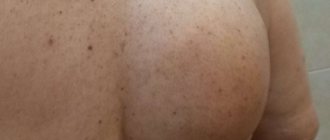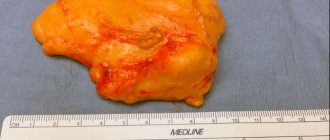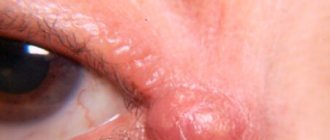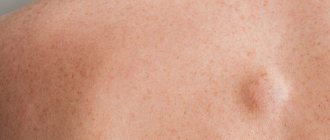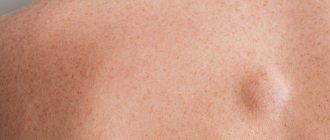Home > Laser surgery / Removal of tumors / Removal of lipomas > Laser removal of wen on the leg
A lump on the leg may not cause discomfort, in which case the doctor will only recommend observation. It is better to remove large fat deposits using a laser.
Fats (lipomas) are benign formations that can appear on different parts of the body. They are soft and mobile to the touch, and the contours of the formation can be easily traced. Small lipomas, if they do not cause discomfort, the doctor may recommend observation. If the tumor is large and discomfort occurs, the specialist usually recommends removing the tumor.
Consultation on the day of the procedure is free
Symptoms
The formation of wen on the legs can occur for a long time without the manifestation of any symptoms. In addition, due to its small size and slow growth, it is difficult to detect in a timely manner.
Wen removal
Wen removal is a method of therapeutic intervention when the tumor reaches a size of 10 centimeters or more.
Due to the lack of pain and discomfort, the patient often postpones a visit to a specialist and seeks medical help only when the tumor reaches large volumes.
If a wen appears in muscle tissue, swelling and swelling can be observed at the site of the lesion. In addition, the person will experience pain while moving.
How is a lipoma removed?
Depending on the results of the tests, the doctor selects the most appropriate treatment method. Previously, surgical excision using a conventional scalpel was widely used. However, this method is imperfect, because Visible scars often remain at the treatment site. Therefore, today they are increasingly using:
- Laser or radio wave method. Both options have proven themselves in the fight against small lipomas. The affected area is treated with light or radio waves formed into a narrow beam. Under the influence of high temperatures, the seal disintegrates layer by layer until it disappears completely. The boundaries of the affected area are “sealed”, which is why there is no need to suture the wound. As a result, the seal is completely removed, leaving no scars, scars, or other visible marks.
- Aspiration puncture. The surgeon smoothly inserts a hollow needle into the seal. Then, using a syringe, all accumulated pus is pumped out of it. The capsule shell remains intact and dissolves on its own after a few days. This method is considered the most minimally invasive, since all “damage” to the skin is reduced to a single puncture, of which soon no trace remains.
Your doctor should decide which method is right for you. Therefore, if you want your lipoma removal done well, call us. Our surgeons are leading specialists in Lobnya, and the technical equipment of the offices is one of the best in the Moscow region. When you contact Harmony, you can be sure of the results.
How to distinguish from other formations
Before starting treatment, it is important to correctly differentiate a wen from inflammation of the lymph nodes and other pathological processes.
To do this, it is important to pay attention to the manifestation of specific symptoms that are present only when a lipoma forms:
- round shape with soft consistency;
- no pain when pressed;
- taking on its original shape after mechanical action on the side of the seal;
- free formation of folds on the upper surface.
In addition, when the wen develops, there is no hyperemia, itching or burning. There is also no increase in body and skin temperature at the site of the lesion.
Causes
It was not possible to establish the exact factors that provoke the appearance of wen on the legs. It is known that the process of formation of lipomas is the result of a violation of lipid metabolic processes in the human body, which can occur against the background of the influence of several factors at once.
The thigh area has a developed blood supply network, so after removing the wen, it is recommended to monitor the sterility of the operated area.
During the healing process, clear liquid may be released from the wound area, so the sterile dressing should be replaced as it becomes wet.Before applying a bandage, the wound is treated with an antiseptic solution.
Cosmetologist, dermatologist, trichologist
Kalinina Olga Alexandrovna
4 years of experience
However, experts have identified several reasons that have a greater negative impact on the formation of tumors.
The main ones include:
- pathologies of the circulatory system, including malignant processes;
- disruptions in the functioning of the endocrine system;
- disruption of the sebaceous ducts, damage to the hair follicle (wen appears in the buttocks area);
- improper functioning of the hormonal system, which can be caused by menopause, gestation, or taking certain groups of medications;
- injury to the epidermis;
- mechanical damage .
Which doctor treats wen
A fatty tumor is a benign tumor that forms under the skin.
Less common factors that contribute to the development of lipomas on the legs include:
- excessive consumption of alcoholic beverages;
- use of low-quality skin care products ;
- pathologies of the thyroid gland;
- severe slagging of the body;
- blockage of sebaceous ducts;
- diseases of the liver , pancreas, pituitary gland.
In addition, wen can appear as a result of wearing tight, uncomfortable shoes, as well as a sedentary lifestyle.
Diagnostics
At the first signs of the development of a pathological neoplasm, you should seek help from a specialist. Thanks to convenient and modern effective methods, diagnosing wen on the lower extremities is not difficult.
Why can our articles be trusted?
We make health information clear, accessible and relevant.
- All articles are checked by practicing doctors.
- We take scientific literature and the latest research as a basis.
- We publish detailed articles that answer all questions.
First, the specialist visually examines and palpates the location of the tumor. He asks the patient about his life history, the time when the lump was discovered, and what manifestations it was accompanied by.
Inflammation of the wen
Inflammation of the wen is a pathological condition manifested by painful sensations, an increase in size, and an increase in body temperature.
Next, an instrumental examination is prescribed, including the following manipulations:
- radiography - allows you to identify the size of the tumor formation and its shape;
- Ultrasound examination - makes it possible to assess the extent to which nearby muscle tissues and joints are involved in the process;
- computer or magnetic resonance imaging - shows the layer-by-layer structure of the wen;
- biopsy with puncture (thanks to this method, it is possible to determine the degeneration of a pathological node into a malignant form).
The diagnostic examination methods listed above are ideally used when the lipoma is located in the thigh area, under the kneecap or on the feet. With their help, it is possible to identify not only benign, but also malignant tumors, which often provoke more serious consequences.
The choice of diagnostic tactics is determined by a specialist. In this case, it is important to pay attention to such indicators as the general condition of the patient and external manifestations of pathology.
The doctor selects a scheme for carrying out therapeutic measures based on the examination data obtained.
Discussion
The etiology of dendritic lipoma remains unclear [3]. Some authors associate the occurrence of this unusual tumor with osteoarthritis, rheumatoid arthritis, psoriasis, diabetes mellitus, and trauma [4-7]. Most researchers regard lipoma as a reactive rather than a neoplastic process. Tree lipoma occurs predominantly in men 40-50 years old [2, 6, 8, 9]. Localization of the process: hip, knee, shoulder, elbow joints. The development of tree-like lipoma in the ankle joints and tendon sheaths of the fingers and toes was noted. In the literature there are descriptions of both multiple and double localization lipomas [10-12]. Tree lipoma is a metaplasia of adipose tissue in the subsynovial layer of the synovium with hypertrophy and villous hyperplasia [13, 14].
Clinical symptoms of lipoma tree: pain, swelling in the affected area, clicking in the joint when moving, limitation of movement. The pathological process is often accompanied by effusion into the joint cavity, signs of chronic synovitis or bursitis. A lipoma located on the tendon disrupts the strength and contributes to its rupture.
The synovial membrane in dendritic lipoma is thickened. The villi of the synovial membrane are hypertrophied, hyperplastic, and can be represented by nodules of various diameters. On the section there is a tree-like lipoma of a soft-elastic consistency of a whitish-yellow color. The lobular pattern of the structure of adipose tissue is erased and barely visible. Unlike pigmented villonodular synovitis, lipoma has a lighter color because it does not contain hemosiderin [13].
Differential diagnosis radiologically and histologically must be carried out with pigmented villonodular synovitis, synovial chondromatosis, synovial hemangioma, xanthoma, a group of chronic synovitis in rheumatic diseases (rheumatoid arthritis, amyloid arthropathy, psoriatic arthritis). The final diagnosis is possible only after a morphological examination.
Treatment
Methods for removing a wen are determined by specialists based on its size and location. Small lesions can be treated with medications, compresses and ointments.
Self-medication is dangerous with complications!
Attention
Despite the fact that our articles are based on trusted sources and have been tested by practicing doctors, the same symptoms can be signs of different diseases, and the disease may not proceed according to the textbook.
Pros of seeing a doctor:
- Only a specialist will prescribe suitable medications.
- Recovery will be easier and faster.
- The doctor will monitor the course of the disease and help avoid complications.
find a doctor
Do not try to treat yourself - consult a specialist.
If a lipoma grows to three or more centimeters in diameter, it becomes necessary to remove it as quickly as possible due to possible compression of adjacent tissues and creating discomfort for the patient.
Effect of low temperature on the tumor
For cryodestruction it is customary to use liquid nitrogen. In the case of severe cooling, the intercellular fluid freezes and further disintegrates the structure of the wen. Subsequently, scars or cicatrices are not formed. The procedure is painless due to the anesthetic properties of the low temperature.
Puncture
Thanks to this method, the contents of the wen are sucked out using a syringe with a needle. The negative point is that the capsule itself remains intact, and in the case of certain factors, a relapse is possible.
Application of radio waves or laser
These methods of removing wen are the most modern and effective. During the procedure there is no direct contact of the device with the skin. Thanks to cauterization, there is virtually no bleeding. Restoration of the skin occurs within five days.
Surgical excision
The operation is performed when the wen on the leg reaches a large size. In this case, anesthesia can be used either general or local. In difficult cases, the doctor may insist on hospitalization.
Consequences
As a rule, a lipoma on the leg is a benign neoplasm and in rare cases degenerates into a malignant form. However, with a long absence of therapeutic measures, the likelihood of various complications increases several times.
What to do if pus leaks from the wen
Lipoma is a benign defect formed by subcutaneous fat cells.
Most often, those seals that have been injured undergo malignancy. The risk of transition to a malignant form also increases against the background of the development of the inflammatory process in the growth. For this reason, doctors do not recommend letting the disease reach such a state and not trying to solve the problem on your own.
The onset of inflammation inside the wen will be indicated by severe pain. Since the lipoma is surrounded by a capsule, the defenses cannot fight the pathology on their own. As a result, if appropriate measures are not taken, the formation may break through, which in most cases is accompanied by the development of sepsis.
If treatment is not started, the tumor begins to grow and can reach large sizes. If muscle fibers are involved in the pathological process, it is possible that the growth will degenerate into an oncological disease.
When the wen grows into the nerve endings, the patient will complain of severe pain. Against this background, restriction of physical activity cannot be ruled out.
If the lipoma is located between the groin and leg, it must be removed immediately. Due to the numerous accumulation of lymph nodes in this area, the tumor can affect them as it grows.
If the wen is localized in the gluteal area, the patient will experience problems with walking and will not be able to sit normally, since any such actions lead to severe pain.
When a tumor forms under the knee, if it is not removed in a timely manner, it can begin to grow into the tendons.
Injury to the wen poses a serious danger. If an infectious process of a purulent or inflammatory nature begins in the wound, this can lead to the destruction of nearby tissues.
Lipomas: are they dangerous to health?
25.06.2021
If a small bump appears on the skin and is unpleasant to the touch, there is no need to panic. Most likely, this is a lipoma - a benign tumor of adipose tissue. This can happen individually or in large groups. Although this does not pose a health risk, for many people it is a serious cosmetic defect that they want to get rid of.
Lipomas - what are they?
Lipoma is a non-cancerous and non- malignant tumor that consists of a capsule of connective tissue in which fat has accumulated. It has an oval or oblong shape, and its size ranges from a few millimeters to several centimeters. Lipomas are most often located in the subcutaneous tissue, but sometimes appear in the internal organs. They grow very slowly, sometimes to very large sizes. Most often they can be found on the back of the head, arms, back , forearms on the extensor side, supracostal area, abdomen , thighs and buttocks.
Lipomas are a disease that occurs mainly in people over 40 years of age; they rarely occur in children. It is estimated that lipomas are a problem in 1% of the world's population.
Reasons for the formation of lipomas
Doctors are not yet sure of the cause of lipomas. Some experts suspect that the appearance of lipomas is influenced by a genetic predisposition to such changes. If close family members have had lipomas , you may have problems with them. According to other data, a gene that is associated with the development of obesity may be responsible for the formation of lipomas, as observed in a study on mice. It is also possible that lipomas appear at sites of minor mechanical damage. Cowden's, Madelung's or Dercum's diseases can also contribute to the development of lipomas.
What types of lipomas are there?
Lipomas are not dangerous to health, however, like other diseases, they also fall under the ICD-10 classification, according to which several types of lipomas can be distinguished depending on the place of their origin:
- lipoma of the skin and subcutaneous tissue of the head, face and neck ;
- lipoma of the skin and subcutaneous tissue of the body;
- lipoma of the skin and subcutaneous tissue of the extremities;
- lipoma of the skin and subcutaneous tissue of other and unspecified places;
- breast lipoma ;
- abdominal lipoma
- lipoma ;
- lipoma of other locations, including the peritoneum and retroperitoneal space;
- unspecified lipoma .
How to treat lipomas?
If you suspect that you have a lipoma , you should consult your doctor . During the visit, the doctor will collect accurate information about when the lump appeared and whether it was enlarged or painful. He will also perform a tumor test to make an initial diagnosis. Some changes require consultation with a surgeon , who may order additional imaging studies.
Lipomas are benign changes that in most cases do not require treatment. However, for many they are a serious aesthetic flaw. There are also cases where the resulting lipoma causes pain, puts pressure on the nerves and limits the mobility of the limbs. The patient may decide to remove the lesion surgically , which is the main treatment for lipomas. During the procedure, the surgeon removes the lesion along with the sac. If the tumor is large, surgery under general anesthesia may be required. The excised lesion is sent for histopathological examination.
There are also less invasive treatments for lipomas. A popular method is liposuction - suction of accumulated fat tissue. It is especially recommended for patients with a large number of small lipomas. This helps to avoid ugly scars on the surface of the skin.
Some patients choose to have steroid injections. They reduce the size of the tumor, but do not eradicate it completely. Doctors avoid this decision because it eliminates the possibility of examining the tumor for histopathology.
Is it really a lipoma?
You can never be absolutely sure that changes in your body are harmless. Every suspicious lump should be checked by a doctor , who will confirm a lipoma or another, much more serious change.
Published in Surgery Premium Clinic
